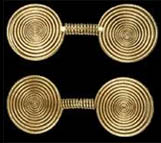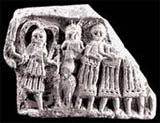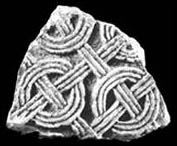
Spiral spectacle pendants are undoubtedly a characteristic of the Delmati cultural group and surely the most popular form of bronze jewellery. They appear during the entire 10th, 9th and 8th century, whereas the exemplars from Livno are among the most beautiful ones of this kind of attire.

A stone icon displaying Diana/ Artemidas, Silvana/ Pana and three nymphs was found at find spot Suhaca. It is considered to be from the 1st or 2nd century.

Carolingian spurs, which were discovered together with swords next to the church in Rešetarica (Podgradina), is a common find and appeared as such in a series of other early Croatian graves in Dalmatia. The striking resemblance of the exemplars in Livno with those discovered in Koljani near Vrlika and the finds in Biskupija near Knin suggests that they -as Dalmatian finds- date back to the end of the 8th or the beginning of the 9th century.

The architrave of an altar screen with inscription was found in the ruins of the early mediaeval church of St. Peter in Rapovina. It dates back to the 9th century.

A pluteus of an altar screen, decorated with three-striped circles that are intertwined with the same kind of stripes. It dates back to the turn of the 10th century and was discovered in the church of St. Peter in Rapovina.
The archaeological monuments of this collection indicate to a millenial connection between the Livno region and the Dalmatian territories. It can be followed from the end of the Copper Age and the beginning of the Bronze Age, i.e. the time when the so-called “Cetina-Culture” was forming in this region, which had developed on the basis of the territorially larger “Ljubljana-Culture” of that time. The fields of Livno, including its surrounding fields in south-western Bosnia and Dalmatia, were the home region of the Delmatae tribal community. Very significant are finds of bronze weapons, tools and jewellery. Epigraphic monuments testify to the slow Romanisation of the Delmatae as well as their worshipping of Pre-Roman and local cults that were mostly interpreted in the images of Silvana and Diane. The area of present-day Livanjsko polje belonged to the Salonitan Archbishopric in the Late Antiquity (early Christian period) until 553 AD when the area was divided into three bishoprics. The area of Livno remained part of the Salonitan Bishopric, which crucially influenced on later historical events, especially during the Middle Ages.